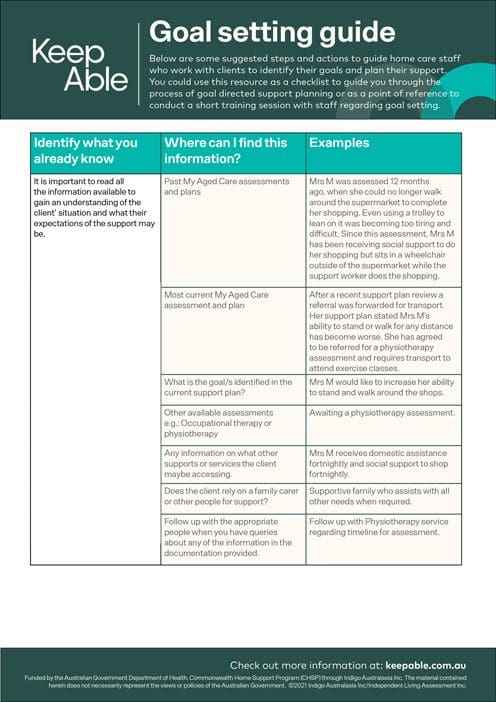Setting goals and achieving them
The majority of us have short and long-term aspirations we wish to achieve. It gives us a sense of direction, and motivation to pursue our goals. As an aged care service provider, supporting your clients in setting goals and achieving them are important elements of the Wellness and Reblement approach.
Scroll down for more information.


For those accessing aged care supports, communication between client and service provider when discussing a client’s goals and planning how to achieve them gives the client a voice, making them feel that their goals are the focal point of the support being provided.
The importance of clients setting goals
There has been doubt within parts of the sector to the importance of goal setting with clients, stating that many older people do not relate to the word ‘goal’ and do not wish to participate in identifying goals. Although, a project undertaken by Melbourne’s East Metropolitan Region (EMR) regarding Goal Directed Care Planning, suggests a different perspective. They surveyed 72 clients and carers who identified the following:
- 86% identified that being asked what they wanted to achieve with our services was important
- 79% reported they would like to set their goals together with staff
- 18% felt they could independently identify their goals, and
- 3% thought the staff should set the goals.
The type of goals they wanted to set were fairly evenly split between:
– Goals about what I hope to achieve with this service (32%)
– Goals that I want to achieve by working with this, and other health services (38%), and
– How my work with this service can help me achieve my general life goals (42%).
82% wanted written information about their care plan (most commonly the agreed actions and goals, staff contact details, and information about other available services), and
86% reported they would use their care plan if they were given a copy.
The most common uses of the care plans identified were:
– As a reminder about actions being taken (55%)
– To talk to family and/or carers about working with this service (48%)
– To keep track of progress (45%), and
– To share with other health professionals involved in care (38%)1.
Goal-setting and goal-directed support planning are fundamental to the success of any person working toward improving, maintaining, or learning a new skill (two of the key objectives of the CHSP Program as detailed below).
- Provide high-quality support, at a low intensity on a short-term or ongoing basis, or higher intensity services delivered on a short-term basis, to frail older people to maximise their independence at home and in the community, enhancing their wellbeing and quality of life.
- Support clients to delay, or avoid altogether, the need to move into more complex aged care by being kept socially active and connected with their community, so that whole-of-system aged care costs can be kept at a sustainable level as the population ages, and the number of people requiring care increases.
If they have not been a focus within your organisation, it is time to re-assess and prioritise. The key to this is making sure appropriate staff are equipped to discuss and document these important conversations with clients and direct support staff are skilled to understand and act on what has been documented.


The evidence
Research studies conducted to measure the effectiveness of goal-directed support planning have identified the positive outcomes clients can achieve when goals and plans have been developed to align with what is important to the client and a collaborative approach to planning with the client and others involved with the support has been followed.
One study published in 2019, with the aim to gain an insight into the results of goal-planning with community-living older adults concluded, “Older adults are able to attain health-related goals through collaborative goal planning. We recommend future integrated care programs for older adults to incorporate goal-planning methods to achieve person-centered care”2
Another study concluded, “Factors that have a positive impact on interdisciplinary collaboration in reablement are participants’ definitions of their goals, the number and variety of professionals involved, how closely these professionals collaborate, the amount of time for communication and shared planning and decision making.”3
There are many factors that may contribute to the lack of, or ‘poor’ goal setting, including organisational culture which undervalues its importance, staffing resources, staff knowledge, and skills to name a few.
What’s available to help you?
Many goal setting resources are available to guide and assist organisations to enhance their skill and knowledge in this important process, but it requires commitment from leadership to ensure that all the required resources such as the time, appropriate training and communication channels are available for staff to enhance their skills in this area.
The KeepAble team have put together a snapshot of good practice steps to promote goal setting using a collaborative and enabling approach. The resource could be used when conducting a team toolbox session with a focus on goal setting or as a reminder to individual staff of ‘good practice’ goal setting steps. Click the image to open the three page PDF document.
And there’s more!
Below are some additional resources and information that can help you when you or your organisation are reviewing and implementing continuous improvement activities related to Goal-Setting and Care-Planning. We hope by providing a number of options, you can find one to work with that suits you and your organisation.
- The Principles for goal-setting resources developed by the Australian Government Department of Health is one of the many practical guides and tools for CHSP providers which will assist them to embed wellness and reablement into service delivery. In developing person-centered goals for clients, there are no one-size-fits-all, but there are certain guiding principles that can help you develop individual goals for your clients. Click this link for access to all resources.
- Goal-Directed Care Planning Toolkit – Whilst developed in 2013 within the context of the Victorian HACC system, many of the practical strategies and person-centered tools detailed in the resource apply to the current CHSP environment. This resource was developed to support good goal-directed care planning practice in the aged care home support sector. The toolkit can be used for staff to review and assess current practices, prioritise, and implement changes to build capacity within the staff. Practical skills-based training is recommended as well.
- Service-specific goal-setting and care planning – This excellent resource provides an overview of person-centered goal-setting and care planning as key elements in the CHSP program.
- Person-driven outcomes goal-setting – This video, intended for those who provide care management services, includes tips and tricks for coordinating goal-based care, illustrated with examples from organisations experienced in providing person-centred care to individuals with complex needs.
- Implementing the Comprehensive Care Standard – This guide was published by the Australian Commission on Safety and Quality in Health Care and provides practical advice for clinicians and health service organisations about goal setting, based on common principles found in many of the goal setting resources.
References
1 Pascale, K (2013). The Goal Directed Care Planning Toolkit: Practical strategies to support effective goal setting and care planning with HACC clients. Eastern Metropolitan Region (EMR) HACC Alliance, Outer Eastern Health and Community Services Alliance, Melbourne, Vic.
2Wanda Rietkerk, Ronald J. Uittenbroek, Debby L. Gerritsen, Joris P. J. Slaets, Sytse U. Zuidema & Klaske Wynia (2019) Goal planning in person-centred care supports older adults receiving case management to attain their health-related goals, Disability and Rehabilitation, DOI: Link to PDF document
3 Birkeland A, Tuntland H, Førland O, Jakobsen FF, Langeland E. Interdisciplinary collaboration in reablement – a qualitative study. Journal of Multidisciplinary Healthcare. 2017;10:195–203

